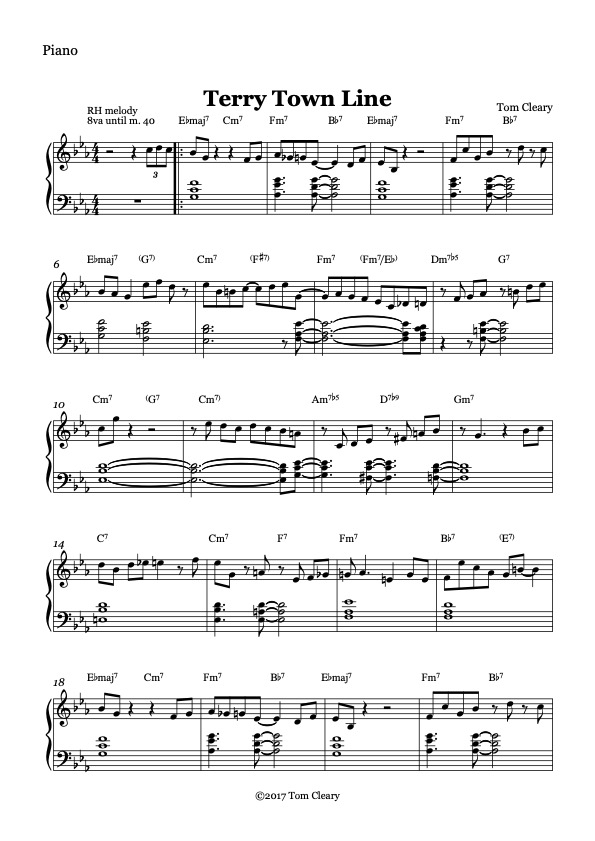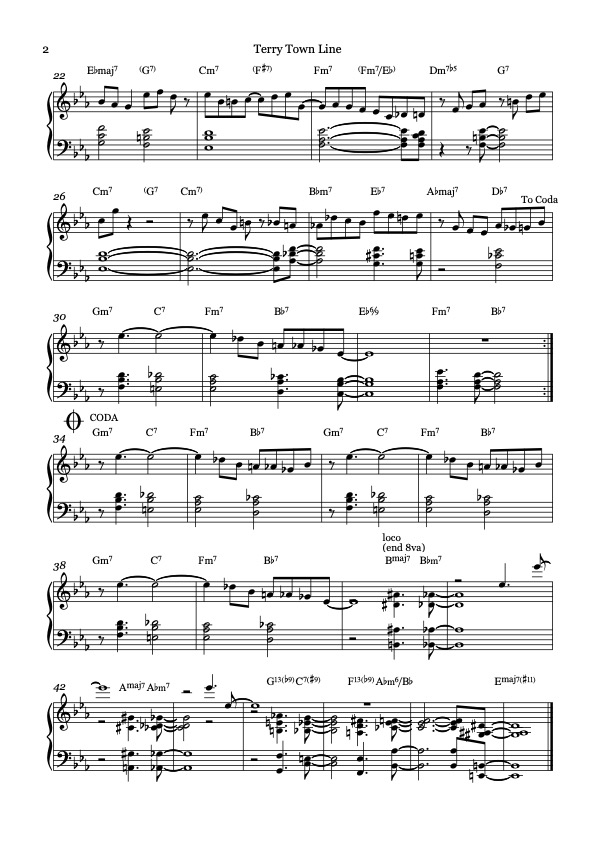‘Terry Town Line’ is a bop line I composed based on the changes to ‘I Could Write A Book’ by Richard Rodgers and Lorenz Hart. The tune is dedicated in part to my mother, Roddy O’Neil Cleary, who for a number of years taught at Marymount College in Tarrytown, New York (which is a stop on the Hudson Line of the Metro North railroad); ‘I Could Write A Book’ is one of her favorite songs. The spelling of ‘Terry’ in the title is a nod to master trumpet and flugelhorn player, composer and educator Clark Terry, with whom I had the honor of playing when he visited the UVM Jazz Studies Program in the early two-thousands. I have to credit Dr. Alex Stewart for bringing Clark Terry to UVM, which led to my opportunity to play with him. Terry played with both the Count Basie and Duke Ellington Orchestras, as well as with Bud Powell, Thelonious Monk and many other jazz luminaries, and led many of his own groups, including a wonderful quintet with valve trombonist Bob Brookmeyer (one of their tunes is mentioned in my post on improvising in the dorian mode.) I also discuss Terry’s playing briefly in my post on Stefon Harris and at more length in a post on piano comping in small combos. If you learn only one thing from this post, I hope it inspires you to check out the music of Clark Terry, a vast and wonderful treasure trove spanning much of jazz history.
I also wrote ‘Terry Town Line’ because ‘I Could Write A Book‘ is in a four-year cycle of audition pieces for the Vermont All State Jazz Ensemble, and so I periodically teach students who audition how to interpret this melody and improvise on its changes. When I begin working with students on standard tunes, I always ask that they learn the original melody (the duo version of ‘I Could Write A Book’ by Fred Hersch and Dawn Upshaw is a gorgeous interpretation of the original melody at a ballad tempo) as well as a melodic outline of the progression using scales and patterns. My current outline for ‘I Could Write A Book’ can be heard here; the recording also includes extra choruses of bass and drum accompaniment so you can practice playing the outline or improvising on your own. (Students auditioning for Vermont All State Jazz Ensemble need to purchase a copy of Jamey Aebersold book ‘All Time Standards’ and use the chart for ‘I Could Write A Book’ found there; photocopies are not accepted in the audition.)
A crucial next step in learning any jazz tune is to listen to interpretations of the tune by master improvisers; to my knowledge, the Miles Davis version of ‘I Could Write A Book’ from ‘Relaxin’ with the Miles Davis Quintet’ is the main reason the tune has become considered a jazz standard. (The Quintet’s arrangement of the tune is an early example of how Miles began to stretch standard song forms: each solo on the form ends with an ‘extended turnback’ that adds twelve bars to the form. The Gm7-C7 | Fm7-Bb7 progression in m. 29-30 of the tune is first played as written and then stretched to twice its length and played three more times, followed by a two bar break for the next soloist. While this harmonic cycling is a harbinger of the vamp-based soloing that would later reach epic proportions on the albums Miles Davis In Europe and In A Silent Way, it is not a standard part of the way jazz players play the tune, and so it is not included in ‘Terry Town Line’. I do recommend Luca Bragliani’s analysis of the Miles Second Quintet’s use of vamps on ‘Miles Davis in Europe’ as an introduction to how Miles’ use of vamps developed.)
‘Terry Town Line’ is partly based on melodic fragments which I’ve borrowed from Clark Terry’s composition ‘Perdido Line’ and adapted to the progression of ‘I Could Write A Book’. (The link in the last sentence is to an Ellington version of ‘Perdido’ which begins with ‘Perdido Line’; Terry lists it as a distinct composition in his autobiography.) I was inspired to use the process of basing a melody on both existing melodic fragments and an existing progression, after discovering that (as I describe in another post) Benny Harris appears to have composed ‘Ornithology’ by borrowing phrases from Charlie Parker’s melodic vocabulary and using them as the basis for a melody on the changes of ‘How High The Moon’. I find that with master player/composers such as Parker and Terry (as well as skilled musical adapters like Harris), there is a natural overlap between improvisational and compositional vocabulary; for instance, the lick I use in m. 15-16 of ‘Terry Town Line’ shows up not only in ‘Perdido Line’ (near the end of the bridge) but also in Louis Armstrong’s solo on ‘Hotter Than That‘ and Miles Davis‘ solo on ‘Oleo‘ (from the version on ‘Miles Davis and the Modern Jazz Giants’.)
It is clear that Benny Harris intentionally used the chord progression of ‘How High High The Moon’ and licks from Charlie Parker’s melodic world to compose ‘Ornithology’. The two tunes also create nearly perfect counterpoint when played together, although it is less clear whether Harris intended ‘Ornithology’ to be used this way. On most recordings of ‘Ornithology’, the two tunes are not played simultaneously, although this has been done a recording by Pete Rugolo and a choral arrangement I did of the tune. I emulated ‘Ornithology’ in designing ‘Terry Town Line‘ as a countermelody to ‘I Could Write A Book’, but in my solo piano recording of ‘Terry Town Line’ , I followed the common performance practice of ‘Ornithology’ in not playing the tunes simultaneously. Pianist Billy Taylor’s comments quoted in a 2011 paper from Current Research in Jazz suggests that contrefacts (tunes based on existing chord changes) were sometimes used as countermelodies in live playing situations. (Karrin Allyson’s recording of ‘Donna Lee/Indiana‘ shows that ‘Donna Lee‘ also works as a countermelody to ‘(Back Home Again In) Indiana’, the tune from which the ‘Donna Lee’ changes originate.)
I hope you enjoy listening to and (hopefully) learning to play or sing ‘Terry Town Line’ and (perhaps) using it as a countermelody for ‘I Could Write A Book’ or a source of ideas for improvising an eighth-note-based bop line on the tune’s changes. My solo piano recording of ‘Terry Town Line’ uses a stride approach in the left hand, but this is only one of many possible chording approaches. I would suggest that pianists begin by learning the melody up the octave (as I play it on the head in) with block chords in the left hand (rather than stride.) A few notes on the charts for the tune, which are below in the four standard transpositions: the chords in parentheses are passing chords that I typically use only on the head, and the small notes at the end of the coda show a background line which a second player could play if there are two melody instruments.





